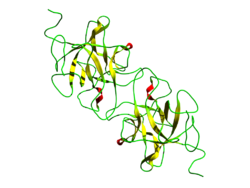Miraculin
| Miraculin ( Synsepalum dulcificum ) | ||
|---|---|---|

|
||
| Belt model according to PDB 3IIR | ||
| Mass / length primary structure | 191 amino acids | |
| Secondary to quaternary structure | Homotetramer | |
| Identifier | ||
| External IDs | ||
| Inhibitor classification | ||
| MEROPS | I03 | |
Miraculin is a glycoprotein from the fruits of the miracle berry ( Synsepalum dulcificum ), a tropical sapote plant .
structure
The composition of miraculin was clarified in 1989, both the polypeptide chain and the proportions of bound monosaccharides. The primary structure of the protein is a chain of 191 amino acids ; in the quaternary structure , two homodimers linked by disulfide bridges are combined to form a tetramer.
effect
Miraculin itself is tasteless, but when the human tongue is exposed to miraculin, even sour foods such as citrus fruits can be perceived as sweet, even for long periods of time. If miraculin is consumed at the same time as acid , it takes a moment for this effect to occur. Until the miraculin starts to work, an acidic mixture tastes the same, only after a delay does a sweet taste appear, which soon overpowers the sour.
The glycoprotein, a protein with a carbohydrate content of around 14%, attaches to a sweet receptor of sensory cells in the taste buds , but does not yet trigger a reaction - at least not at a neutral pH value, as Japanese researchers at the University of Tokyo did in October 2011 reported. However, if you eat acidic food, the environment in the mouth shifts to the acidic range - and miraculin takes on a slightly different shape and the conformation of its tertiary structure changes . As a result of the changed shape, the taste receptors are now activated and the taste sensory cells of the tongue are stimulated, the downstream afferent neurons are excited, signals are sent to the sensory cranial nerve nuclei ( Nuclei tractus solitarii ) in the medullary brain and from there to the gustatory cortex , so that the sensation is “intensely sweet “Can be perceived - although the food consumed would normally leave a sour taste.
history
Since the miracle berry itself has hardly any taste of its own , the taste conversion was viewed as a miracle, hence the name. In West Africa the miracle berry was used to improve the taste of acidic dishes.
The active substance that the Japanese scientist Kenzo Kurihara isolated was named after the miracle fruit when he published his work in Science in 1968 .
Miraculin could be used in the future as a low-calorie sweetener suitable for diabetics . However, production is currently still too expensive. Attempts to produce miraculin on the basis of genetic engineering could serve to produce a new sugar-free sweetener . For example, Japanese scientists have been successful in creating genetically modified plants such as garden lettuce that produce miraculin. Approaches to production using genetically modified bacteria ( Escherichia coli ) have already been described.
Miraculin is used in the United States for the relief of chemotherapy-induced taste disorders . The effectiveness has been confirmed by initial pilot studies.
Individual evidence
- ↑ S. Theerasilp, Y. Kurihara: Complete amino acid sequence and structure characterization of the taste-modifying protein, miraculin . In: J. Biol. Chem. . Volume 264, No. 12, April 1989, pp. 6655-6659. PMID 2708331 .
- ↑ UniProt P13087
- ↑ H. Igeta, Y. Tamura, K. Nakaya, Y. Nakamura, Y. Kurihara: Determination of disulfide array and subunit structure of taste-modifying protein, miraculin . In: Biochim. Biophys. Acta . Volume 1079, No. 3, September 1991, pp. 303-307. doi : 10.1016 / 0167-4838 (91) 90073-9 . PMID 1911854 .
- ↑ A. Koizumi, A. Tsuchiya, K. Nakajima, K. Ito, T. Terada, A. Shimizu-Ibuka, L. Briand, T. Asakura, T. Misaka, K. Abe: Human sweet taste receptor mediates acid- induced sweetness of miraculin. In: Proceedings of the National Academy of Sciences of the United States of America . Volume 108, Number 40, October 2011, pp. 16819-16824, ISSN 1091-6490 . doi : 10.1073 / pnas.1016644108 . PMID 21949380 . PMC 3189030 (free full text).
- ↑ JP Slack, A. Brockhoff, C. Batram, S. Menzel, C. Sonnabend, S. Born, MM Galindo, S. Kohl, S. Thalmann, L. Ostopovici-Halip, CT Simons, I. Ungureanu, K. Duineveld, CG Bologa, M. Behrens, S. Furrer, TI Oprea, W. Meyerhof: Modulation of bitter taste perception by a small molecule hTAS2R antagonist. In: Current biology: CB. Volume 20, Number 12, June 2010, pp. 1104-1109, ISSN 1879-0445 . doi : 10.1016 / j.cub.2010.04.043 . PMID 20537538 . PMC 2925244 (free full text).
- ↑ K. Kurihara, L. Beidler: Taste-modifying protein from miracle fruit. In: Science. Volume 161, September 1968, pp. 1241-1243. PMID 5673432 doi : 10.1126 / science.161.3847.1241
- ↑ Matsuyama et al. (2009): Functional Expression of Miraculin, a Taste-Modifying Protein in Escherichia Coli. In: J Biochem Vol. 145, pp. 445-450. PMID 19122203 doi : 10.1093 / jb / mvn184
- ↑ Marlene K. Wilken, Bernadette A. Satiroff: “Pilot study of 'miracle fruit' to improve food palatability for patients receiving chemotheraphy”. In: Clinical Journal of Oncology Nursing, Vol. 16 No. 5, pp. 173-177. Oncology Nursing Society, 2012, accessed March 11, 2020 .
- ↑ Soares, HP, Cusnir, M., Schwartz, MA, Pizzolato, JF, Lutzky, J., Campbell, RJ, Beaumont, JL, Eton, D., Stonick, S., Lilenbaum, R .: “Treatment of taste Alterations in chemotherapy patients using the 'miracle fruit': preliminary analysis of a pilot study ”. In: Journal of Clinical Oncology 28, no.15_suppl. American Society of Clinical Oncology, 2010, accessed March 11, 2020 .
